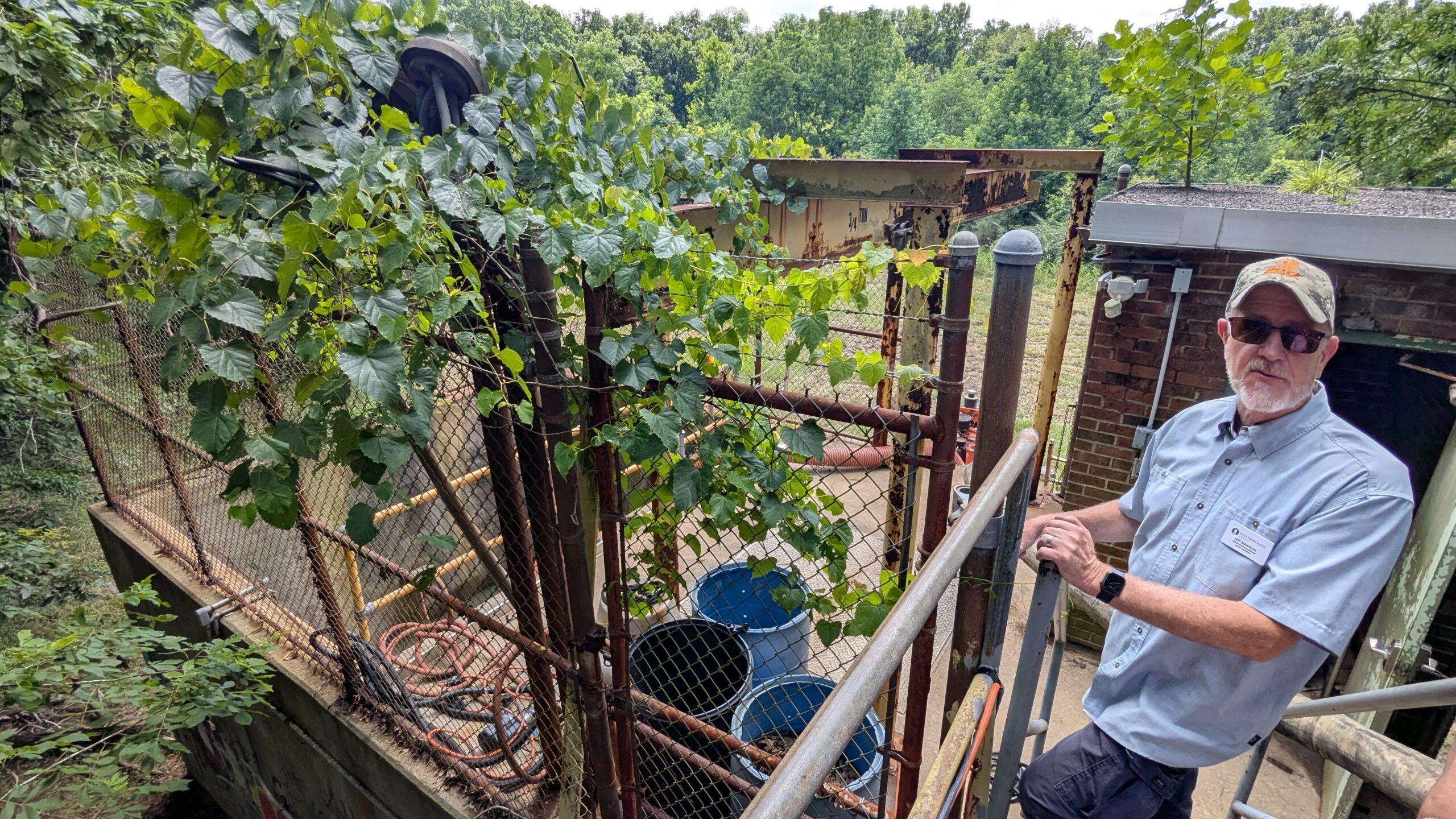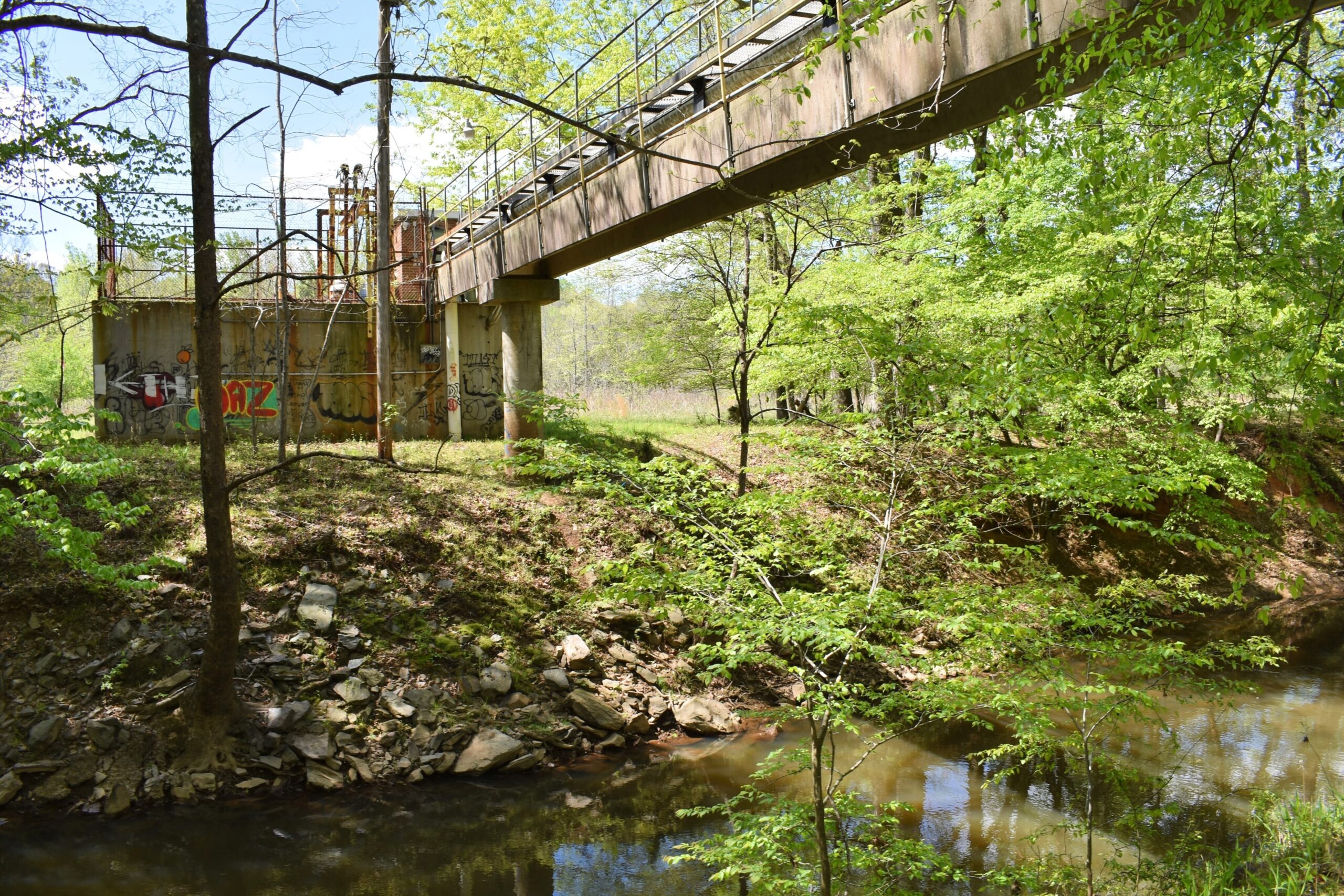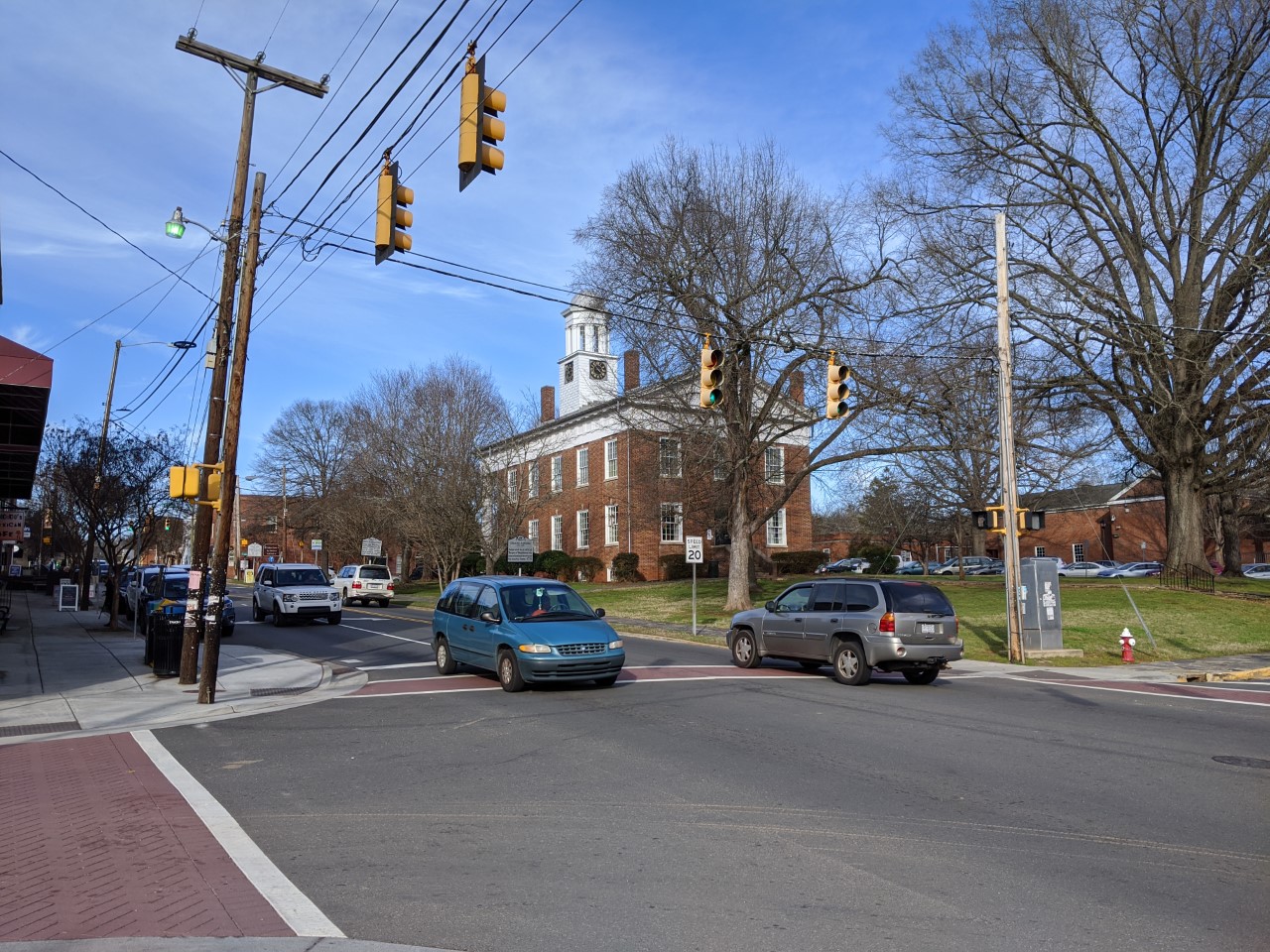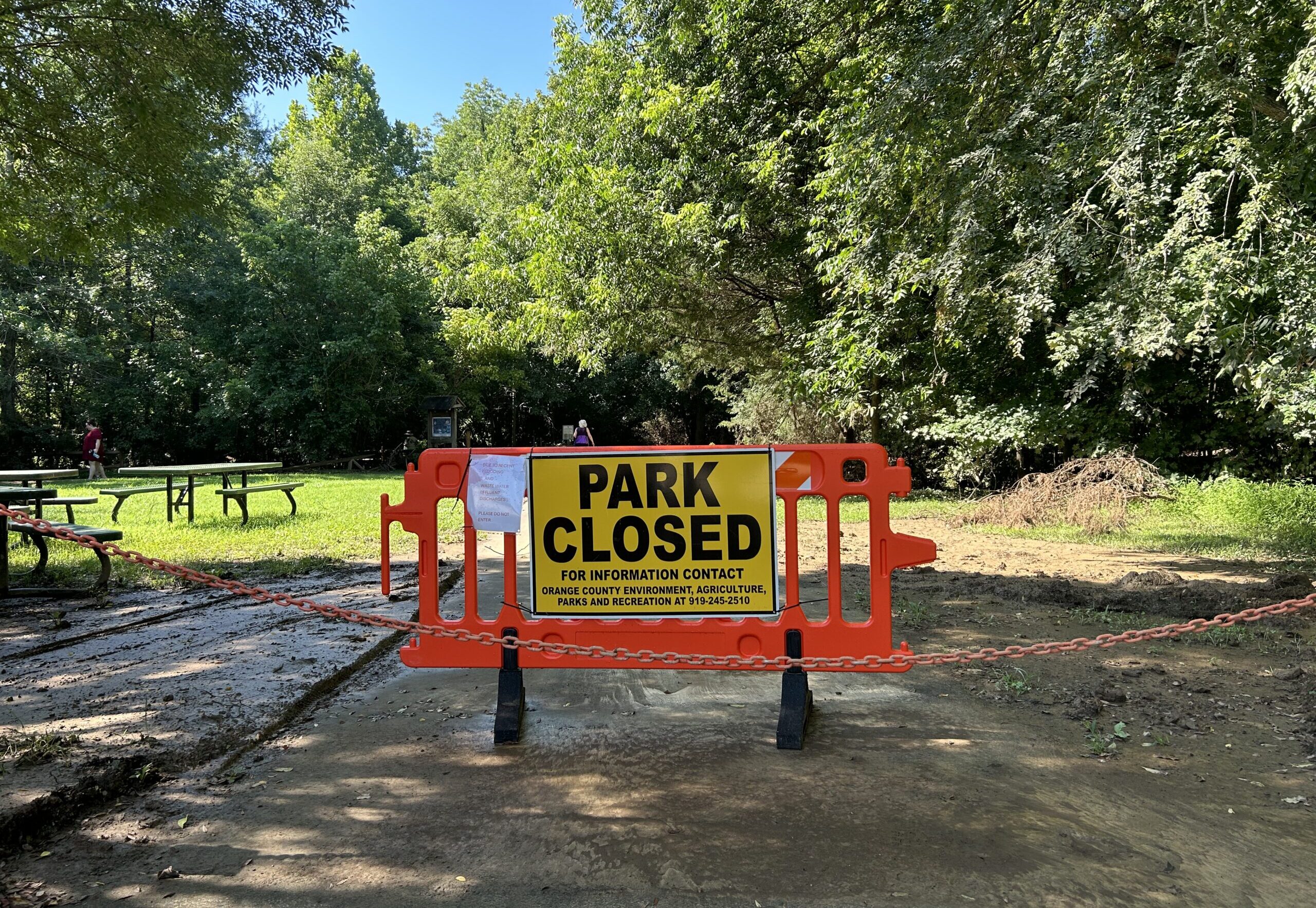While the Town of Hillsborough ended its conservation call for water and sewer customers after flooding damaged and contaminated its treatment plants, the road back to normal operations appears to be long for the small town.
Historic rain from Tropical Depression Chantal led to flooding levels not seen for decades in Orange County, with parts of Hillsborough throttled by the Eno River. Floodwaters limited the town’s clean water supply, which caused the initial call for water conservation — but the flooding at a critical piece of wastewater infrastructure in the floodplain is what may cause an extended financial strain.
As Deputy Utilities Director for Water Treatment Jeff Mahagan used the walkway over the pipe of the River Pump Station, he pointed out its concrete facility on the bank of the Eno. The site sits near a convergence of sewer lines and uses electric pumps to send the raw wastewater to the plant on the other side of the river. Mahagan said when crews arrived in the aftermath of the storm on Sunday, there were several inches of water above the standing platform of the pump station — meaning all the equipment was waterlogged and marking the biggest flood seen since Hillsborough opened its reservoir in 2000.
“When [Hurricane] Fran came through, the water level came [pretty] close to going over and flooding the pump station,” said Mahagan. “And everybody thought, ‘That was a once in a lifetime storm, we’re never going to get that again.’
“But we did,” he said with a chuckle, “and even worse.”

Hillsborough Deputy Utilities Director for Water Treatment Jeff Mahagan stands at the River Pump Station during a brief tour on Friday, July 11 to show the temporary bypass pumps in place and to describe the flood damage. (Photo by Brighton McConnell/Chapel Hill Media Group.)
At a press availability held by the town on Friday afternoon, Town Manager Eric Peterson said staff did their best to prepare for severe weather. After forecasts showed Chantal moving through central North Carolina, Hillsborough employees quickly moved vehicles and equipment to areas projected to be safe from major flooding. But as they quickly found out, Peterson said, this was no ordinary flood.
“After Hurricane Helene,” the town manager said, “our emergency management team internally reviewed flood maps to try to identify potential evacuation areas and make adjustments to town facilities at a level that we’ve never even seen before. We even took it to a 500-year flood level.
“Our early projections are that [Chantal] was close to a 1,000-year flood event,” he continued. “Much of the equipment, infrastructure and vehicles that were destroyed or heavily damaged in Hillsborough were not only outside of the 100-year flood plain, they were outside the 500-year benchmark.”

Hillsborough Town Manager Eric Peterson addresses the media at a press conference on Friday, July 11, with Mayor Mark Bell and Utilities Director Marie Strandwitz standing by. (Photo via Brighton McConnell/Chapel Hill Media Group.)
According to rainfall amounts reported by the state, Hillsborough saw the third most of any town from the storm — with 10 inches of rain dropped in just a few hours, and 13 inches of rain dumped into the rivers upstream that eventually flowed to the community. With the gravity sewer pipes near the river pump station overflowing from floods, untreated wastewater went directly into the Eno River for days instead of getting to the treatment plant. The local government estimates roughly 75% of their customers’ wastewater is serviced by the damaged pump station, and repairs are now estimated to take several weeks.
While Hillsborough successfully connected temporary pumps to bypass the damaged ones, Mayor Mark Bell discussed how the long-term future of the station is still an issue.
During the Biden administration, the town government earned $6.8 million in grant funding from FEMA’s Building Resilient Infrastructure and Communities (BRIC) program to redesign and move the infrastructure away from the floodplain. It served as an example of what the BRIC program — which began during Donald Trump’s first presidential stint — aims to do: help local governments proactively improve their infrastructure’s resiliency to severe weather compared to after.
But, as the mayor pointed out on Friday, the Trump administration cancelled the BRIC program and its grant recipients’ funding entirely in April of this year. While nothing could have been done to prevent Chantal’s flooding from damaging the wastewater pump station, it leaves Hillsborough facing a tremendous rebuild, redesign and future relocation with little to no financial assistance.
“Temporary bypass pumps are being installed now and replacements will be installed in the months ahead,” Bell said on Friday, “but the river pump station must eventually be relocated to ensure the health of the community and to allow for future economic development in Hillsborough. To be clear: the impact of Tropical Storm Chantal on the river pump station is exactly the type of scenario that BRIC grants were intended to protect the public against.”

On a normal day, the Eno River sits several feel below the River Pump Station. But even in flood less intense than Tropical Depression Chantal’s, the nearby sewer lines and station’s infrastructure has been threatened — increasing the urgency of needing to relocate the key tool. (Photo via the Town of Hillsborough.)
Public Utilities Director Marie Strandwitz said the town is still gathering its cost estimates for the damage and manpower to quickly restore functionality to both water treatment plants. Before the flooding, the local government was pivoting to see if North Carolina could grant them funding for the pump station’s relocation — but there is no guarantee it will qualify and will further extend the project.
“I think they are working very hard on a way to try to prioritize those that lost the funding under the Hazard Mitigation Grant Program,” Strandwitz said. “But, unfortunately, that will set our timeline back at least six to eight months because they will not start reviewing applications until this fall and into the winter.”
Hillsborough’s water operations are not the only part of the town that will face significant costs from the flooding, as its public works department took a big hit to its resources. Public Works lost its operations building, office trailer, and a third of its equipment for solid waste and street service. Peterson said they are using equipment from other facilities and nearby local governments to cover any gaps in service, but long-term replacement will require mutual-aid assistance.
Additionally, some of the town’s prized Parks and Recreation facilities along the Eno River will need significant repair and recovery too: the Riverwalk and Gold Park.
“For those that are familiar in the area with Gold Park,” Peterson said, “the restroom facilities are the furthest asset that is away from the river and the flood levels that far away still reached six feet in that facility. All of the bridges and boardwalk and other facilities along the Riverwalk are doing engineering assessments, making sure they’re structurally okay. We’re already coordinating repairs, but it’s going to be at least weeks before we can possibly get those facilities back online.”
Chapelboro.com does not charge subscription fees, and you can directly support our efforts in local journalism here. Want more of what you see on Chapelboro? Let us bring free local news and community information to you by signing up for our newsletter.







